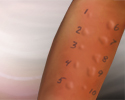Allergies, asthma, and pollen
Reactive airway - pollen; Bronchial asthma - pollen; Triggers - pollen; Allergic rhinitis - pollen
In people who have sensitive airways, allergy and asthma symptoms can be triggered by breathing in substances called allergens, or triggers. It is important to know your triggers because avoiding them is your first step toward feeling better. Pollen is a common trigger.
Pollens
Pollen is a trigger for many people who have allergies and asthma. The types of pollens that are triggers vary from person to person and from region to region. Plants that may trigger hay fever (allergic rhinitis) and asthma include:
- Some trees
- Some grasses
- Weeds
- Ragweed
Watch the Weather and the Season
The amount of pollen in the air can affect whether you or your child has hay fever and asthma symptoms.
- On hot, dry, windy days, more pollen is in the air.
- On cool, rainy days, most pollen is washed to the ground.
Different plants produce pollen at different times of the year.
- Most trees produce pollen in the spring.
- Grasses usually produce pollen during the late spring and summer.
- Ragweed and other late-blooming plants produce pollen during late summer and early fall.
When Pollen Levels are High
The weather report on TV or on the radio often has pollen count information. Or, you can look it up online. When pollen levels are high:
- Stay indoors and keep doors and windows closed. Use an air conditioner if you have one.
- Save outside activities for late afternoon or after a heavy rain. Avoid the outdoors between 5 a.m. and 10 a.m.
- Do not dry clothes outdoors. Pollen will stick to them.
- Have someone who does not have asthma cut the grass. Or, wear a face mask if you must do it.
Keep grass cut short or replace your grass with a ground cover. Choose a ground cover that does not produce much pollen, such as Irish moss, bunch grass, or dichondra.
If you buy trees for your yard, look for tree types that will not make your allergies worse, such as:
- Crape myrtle, dogwood, fig, fir, palm, pear, plum, redbud, and redwood trees
- Female cultivars of ash, box elder, cottonwood, maple, palm, poplar or willow trees
References
American Academy of Allergy Asthma & Immunology website. HOME allergy management. acaai.org/resources/tools/home-allergy-management. Accessed July 25, 2022.
Cipriani F, Calamelli E, Ricci G. Allergen avoidance in allergic asthma. Front Pediatr. 2017;5:103. PMID: 28540285 pubmed.ncbi.nlm.nih.gov/28540285/.
Corren J, Baroody FM, Togias A. Allergic and nonallergic rhinitis. In: Burks AW, Holgate ST, O'Hehir RE, et al, eds. Middleton's Allergy: Principles and Practice. 9th ed. Philadelphia, PA: Elsevier; 2020:chap 40.
Review Date: 6/7/2022
Reviewed By: Neil K. Kaneshiro, MD, MHA, Clinical Professor of Pediatrics, University of Washington School of Medicine, Seattle, WA. Also reviewed by David C. Dugdale, MD, Medical Director, Brenda Conaway, Editorial Director, and the A.D.A.M. Editorial team.


